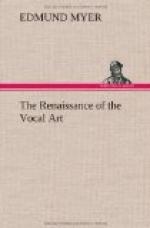No real interpretation is possible without a full comprehension of the meaning of both words and music. Study the voice. Study its possibilities and its limitations. Study music until the musical element of difficulty is reduced to a minimum, and until the character, style, and traditions of the various song forms are well within your grasp. No matter how beautiful may be the voice, or how well placed, no amount of enthusiasm or temperament can atone for a meaningless or unintelligent treatment of the intellectual, emotional, and musical characteristics of the song as a whole.
SUPPLEMENTARY NOTE.
The tendency of many is to raise the hands and arms too high; the hands should not be raised above the waist-line. If raised too high, the energy is often put in the action of the arms instead of the body; or the upper part of the body only is moved, and thus the most important effect or influence for power and control is wanting. The action must be from the hips up, and not only from the hips, but the hips must act and expand with the body. Remember the center of gravity must be at the hips. If it is found that the tendency is to raise the hands too high, then try or study the action as follows:
Place the hands upon the hips, and when coming into action, when seeking the level of the tone, or during the act of singing, see that the hips expand freely and evenly with the body. This should be tried and practiced frequently by all in order that the movement may be from the hips up and not above the hips only. When the hips are thus brought into action, the abdominal muscles and the diaphragm are strengthened, and their position and action are correct. When the upper part of the body only is brought into action the position of the diaphragm and abdominal muscles is often weakened. Remember that the basic law or foundation principle of our whole system of movements is movement from the hips up, including the action or expansion of the hips in connection with the movements of the entire body.




